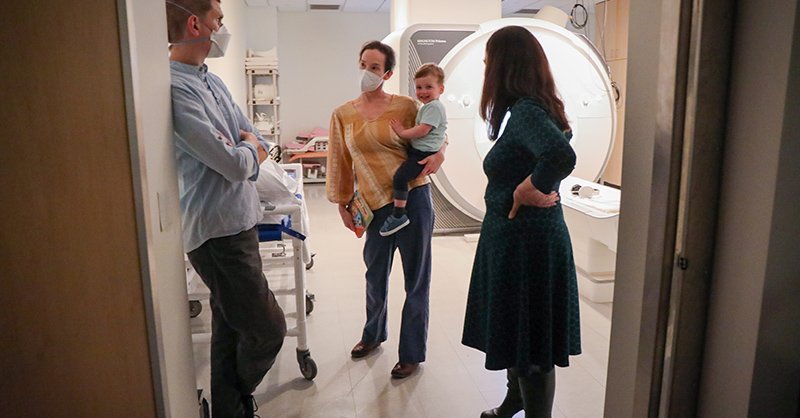
Researchers at OHSU’s Center for Mental Health Innovation have identified a new biomarker related to body fat composition during pregnancy that is associated with mental health outcomes in offspring. (OHSU/Christine Torres Hicks)
Researchers at the Center for Mental Health Innovation at Oregon Health & Science University have identified why obesity during pregnancy, or increased body fat, is associated with an increased risk of mental illness in offspring.
The study was recently published in the journal Brain, behavior, and immunityinvestigated whether pregnancy or cord blood concentrations of two important hormones associated with fat mass, adiponectin and leptin, predict mental disorders in the infant. Leptin, a hormone that regulates appetite, and adiponectin, a hormone that supports blood sugar regulation and fat breakdown, are both crucial for fetal development.
“The association between obesity during pregnancy and mental health in offspring is becoming increasingly clear, but the mechanisms underlying this relationship remain unclear. This is the first study to demonstrate an association between the two hormones and offspring behavioral outcomes.”

Dr. Elinor Sullivan (OHSU)
“The relationship between metabolic status during pregnancy and childbirth and mental health in children is relatively new, and there is little research available to explain the relationship,” Dr. Elinor Sullivan“It is thought that metabolic status influences the environment in utero, which may shape the fetal brain and its development,” said OHSU School of Medicine professor of psychiatry and lead author of the study.
“By identifying new biomarkers, we may be able to predict at a very early stage which children are at risk for common mental disorders such as ADHD and anxiety, allowing targeted early intervention.”
Biomarkers, or measurable characteristics within the body, can act as early warning systems for potential diseases or conditions and are valuable tools to better understand personal health.

Dr. Hannah Gustafson (OHSU)
Led by Sullivan Dr. Hannah GustafsonThe researchers collected data from a cohort of more than 300 pregnant women and their children, taking blood samples from the parents during the second trimester and umbilical cord blood samples at birth. The children were brought in for evaluation at six months of age, at which point the researchers administered standard behavioral tests to examine emotion regulation behaviors, a strong indicator of risk for childhood psychiatric disorders.
The findings suggest that low levels of the hormone adiponectin in parental blood and high levels of leptin in umbilical cord blood may be new biomarkers for the risk of psychiatric disorders in offspring.
The researchers say identifying these biomarkers could hold great promise for early intervention in children at risk for various psychiatric disorders, suggesting that identification of at-risk children may be possible earlier than commonly thought – at birth or even before birth. Moreover, these biomarkers can be measured in clinical settings using standard, low-cost tools and assessed using a single test that is easily interpreted.
The research team’s next step is to test interventions aimed at reducing perinatal child mental health risks and supporting parents. There is promising evidence that teaching parents practical skills during pregnancy can help support the wellbeing of both parents and children. For example, teaching them how to swaddle and soothe a crying baby, providing information about typical infant crying patterns, and offering mindfulness techniques to help manage their own emotions when caring for an infant.

Jamie Law, MD, MCR (OHSU)
“Weight is a complex and sensitive issue for pregnant women, and our goal as clinicians is to help patients take the best possible care of themselves and their developing fetus.” Jamie Law, MD, MCR, “These findings suggest that it may be possible to intervene early in pregnancy to improve the health of the child,” said Dr.
Lo also stressed the importance of access to quality prenatal care, including counselling on nutrition and healthy lifestyles during and before conception, which is crucial to optimising the health of pregnant women and their babies.
“Further research is needed to better understand the nature of these associations and to see whether the behavioral health outcomes persist throughout childhood,” Sullivan said. The team plans to follow participants through age 5 to determine how these factors may predict long-term risk and clinical diagnoses.
“This is a great first step, but there’s much more to learn, including what role social determinants of health play,” Sullivan said. “We look forward to furthering our research and supporting improved care for birthing parents and their children.”
Research reported in this publication was supported by the National Institute of Mental Health of the National Institutes of Health under Grant Numbers R01MH117177, R01MH124824, and K01MH120507, and by the National Center for Advancing Translational Sciences under Grant Number UL1TR002369. The content is solely the responsibility of the authors and does not necessarily represent the official views of the National Institutes of Health.

